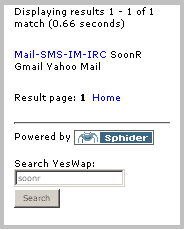A side effect of all the buzz about the mobile web lately is that there are a number of new tools and resources for mobile web developers out on the web.
The W3C, the international web standards organization, has a new alpha quality Mobile Web Best Practices Checker. This checker is a tough grader, it seems almost impossible to find a site that passes with zero errors. I checked yeswap.mobi and the checker reported 2 errors. It didn’t like that I used the xhtml-mp doctype even though it’s far and away the most popular mobile doctype and the one recommended by .mobi and most carriers. It also claimed the markup was invalid even though the W3C’s own validator and Validome.org found no problems. I think it’s still useful to test your page with the W3C checker. Like the MobiReady checker, it goes beyond just testing for valid markup to verify things like reasonable page size and usability factors – just validate any reported errors independently. There’s a good discussion of the checker on Dominique Hazaël-Massieux’s blog Don’t Call me DOM. Dom works for the W3C and is the contact person for the Checker and the W3C’s other new mobile web resource Planet Mobile Web, a website that aggregates over 30 mobile web themed blogs, including this one. Planet Mobile Web is great – if you only read one mobile web related site – make it Planet Mobile Web.
Luca Passani, the WURFL co-author, has added several sections to his Global Authoring Practices (GAP) document including a very nice set of templates for creating mobile pages. GAP also has an extensive references section with links to dozens of web resources for mobile deveopers. Luca wrote GAP as a result of his frustrations with the W3C’s own Mobile Best Practices document which he feels doesn’t accurately describe the practices developers need to use to get their sites working well on today’s shipping mobile browsers.
Over at dev.mobi, there is another set of mobile site templates available for download. Also, Ruadhan O’Donoghue of dotMobi has published a WordPress Plug-in that creates a mobile version of any WordPress blog. Ruadan’s plug-in is based on Alex King’s WordPress Mobile which creates more of a cHtml PDA type site. Ruadhan has extended Alex’s code to produce valid xhtml-mp mobile pages and to use WURFL for mobile browser detection. Speaking of WordPress mobile plug-ins, Mike Rowehl has created one (again based on Alex King’s original) that passes the W3C’s Best Practices Checker!
According to the IE Mobile Team Blog, Microsoft has finally gotten the User Agent religion – future versions of IE Mobile will send there own unique user agents which will make the WURFL guys job a bit easier. Up to now all of the dozens of Pocket IE equipped phones sent one of two user agents regardless of screen size, color depth, download capabilities etc. The article announcing this change also has information about other headers that IE Mobile has always sent specifying screen resolution, color depth, the CPU, etc. and a meta tag you can use to tell IE mobile that your site is a mobile one.
etc. The article announcing this change also has information about other headers that IE Mobile has always sent specifying screen resolution, color depth, the CPU, etc. and a meta tag you can use to tell IE mobile that your site is a mobile one.
My own contribution is a mobile template for the Open Source Sphider site search I wrote about recently. With Sphider and the template you can add a full featured search engine to your mobile sites. The template’s search form is rendered in xhtml-mp or wml depending the html headers it receives from the browser. The template is available on the download page. You can see it in action at yeswap.com and wapreview.mobi.
Related on Wap Review:
Dear all,
I just want to inform about nice WAP service for your PDA or handphone.
If you like accessing to WAP sites from your PDA, cell phone or smartphone, now there is Seriboo Mobile, an interactive mobile media services. You can access Seriboo Mobile at http://wap.seriboo.com/ from your mobile devices.
We have a bunch of features on Seriboo Mobile, such as:
– Chat (public and private)
– Blog (mobile blog)
– Mini Advertisement (cell phone, house, land, website etc)
– News (detik, kompas, metrotv, suara merdeka etc)
– NetTools (domain checker, domain whois, ping etc.)
– E-mail (send email)
– Currency Converter and Rate
– Dictionary (eng to ind, ind to eng, eng to eng)
– Horoscope
– Stock Quotes
– Soccer Score (covers mostly leagues around the world)
– Shout Message
– and more…
So, access http://wap.seriboo.com/ from your mobile device now.
If you want to try it from PC, you can use the Opera browser or Mozilla Firefox with WMLbrowser add-on.
Thanks.
Seriboo Mobile
wap.seriboo.com
Pingback: Blog Posible » Blog Archive » Otras buenas prácticas sobre web móvil más realistas con los navegadores móvil actuales
Thanks for the comment, Andrea.
You are probably right, we won’t really know until Windows Mobile devices with the new User agents start shipping. I read the following from the IEMobile Team Blog to mean that each different manufacturers subversion would have a unique value in the “n” at the end of the User agent string:
Probably just wishful thinking on my part.
You are so right that MS really does need to follow standards though rather than making up their own.
Dennis
I have to disagree about the idea that the new IE Mobile user-agent will make it easier to recognize the devices. It’s just the same as before, simply there isn’t PPC and Smartphone anymore, but all the devices running MS’s operating systems will still identify themselves with the same user-agent.
Not a big help at all!
You may also read more comments about this here, new MS IEMobile user-agents.